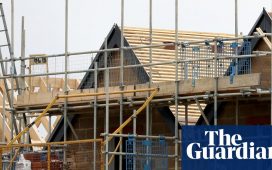Good morning. Nvidia shares are down almost 17 per cent since Thursday. This shocking turn of events leaves the chipmaker’s shares up just 2,800 per cent or so over the past five years. Sad! Think Nvidia is a bargain again? Email me: robert.armstrong@ft.com.
Housing
The last time Unhedged took a look at the US housing market, back in March, we wrote that
The housing market has been stuck, and it’s still stuck . . . given the current economic set-up [the most likely outcome] is that housing remains an oasis of sluggishness in an otherwise strong economy, and most American families are stuck paying high rents and gazing through brokers’ windows at unaffordable houses
I’m sorry to report things have, somehow, turned out even worse than we feared. The housing market has achieved an ugly combination of weakening demand, falling investment, increasing supply, and rising prices that would be impossible in a just and orderly world.
Start with the headline numbers from last week. New housing permits and construction starts took a meaningful step down in May, bad news for a country chronically undersupplied with housing:

Why is the homebuilding industry putting on the brakes? Probably because in 2024 new home sales have subsided to sub-2019 levels:

The problems are not limited to the new home market. Here, from Zillow, is the rate of change in total home sales. Sales had been falling more slowly, but when they hit break-even they reversed course and headed back down. The sales deficit of 2022 and 2023 is not being made up; the market remains frozen.

Meanwhile, inventories of homes for sale continue to rise. Below are Zillow’s figures. The National Association of Realtors figures agree; they show inventories up 18.5 per cent year-over year in May.

The rising inventories of new homes has been enough to halt the rise in homebuilders stocks since this spring. But, somehow, not house prices! Having briefly touched zero last year, prices growth promptly picked up again:

David Rosenberg of Rosenberg research states the madness of this neatly: “When it comes to the housing market, the laws of supply and demand don’t seem to apply any longer . . . Demand at a four-month low, supply at a four-year high, and prices at unprecedented heights.”
The horror of this combination is summed up by the Atlanta Fed’s Home Ownership Affordability index. It measures the ability of a US household earning the median income to afford a median-priced house, assuming a 10 per cent down payment, and that 30 per cent of income is the most that should go to housing. The index is as low as it has been since 2007, though for different reasons. Then the main barrier to affordability was price; now the main problem is mortgage rates.

To be fair, according to the NAR, home price increases are almost all driven by houses priced above $500,000, that is, above the median. And as Rick Palacios of John Burns Research pointed out to me, home prices in parts of Texas (Austin and San Antonio) and Florida (Sarasota, Punta Gorda, Fort Myers) have internalised the reality of 7 per cent mortgage rates and are now falling year-over-year. Palacios expects inventories to keep building and prices to remain under pressure until the mortgage rate falls. So does Nancy Vanden Houten of Oxford Economics:
I do think . . . we will start to see prices soften in the months ahead. With mortgage rates at current levels and prices where they are, homebuying has become unaffordable for most households . . . while supply may still be relatively tight, it has increased and if sellers want to sell their homes, they will, similar to 2022/early 2023 have to make some price concessions. One difference between now and then, however, is that in 2022 we were at the start of the Fed’s rate hiking cycle and now we’re close to the beginning of a rate cutting cycle. So while we may see some near-time declines in home prices . . . I don’t think we will see sharp declines in prices
But small declines in prices will not be enough to solve the affordability problem if mortgages do not become radically cheaper. Even then, the housing market in America will remain a significant social problem that goes a long way towards explaining consumers’ dissatisfaction with an economy that is healthy in other ways.
Whether the current slowdown in the housing market is also a significant economic problem is trickier. Housing investment is not a large part of US economy, but it moves around a lot, so it can be important on the margin. In 2022 and 2023, it detracted almost half a percentage point from real GDP growth; in 2021, it added that much.
That is enough to catch the attention of the Federal Reserve as it decides on rate policy, but the decisions before the central bank are not simple. Some cooling of the economy is welcome with inflation not quite back to 2 per cent yet. At the same time, more, not less housing investment is needed over the long term to keep rent inflation under control. And the Fed doesn’t want a decline in construction employment to lead to wider job losses either. Unhedged’s frequent correspondent Don Rissmiller of Strategas thinks that the housing mess shows that it’s time for the Fed to cut:
I’m taking the (terrible) US housing data as more of a signal that monetary policy rates need to be adjusted . . . There’s still enough going right in the US, with the help of fiscal policy support . . . but this cannot be relied on indefinitely. Interest rate-sensitive parts of the US economy are already under pressure. If the central bank wants to achieve a soft landing they should start to dial back policy restrictiveness, before small cracks become big cracks.
Long term, what the American economy needs is more houses, at lower prices, in the places where the growth is. Low rates cannot achieve this alone, as the post-financial crisis of ultra-low rates proved, and rate normalisation has proven a maddeningly slow way to bring prices under control. The solution must lie elsewhere.
One good read
The miracles of globalisation.











